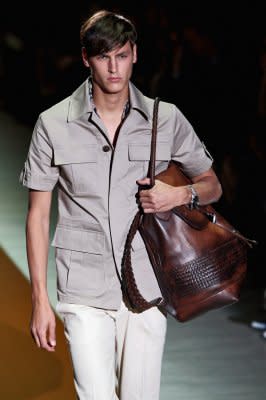Are Designer Logos Shrinking?

If donning designer labels is like flaunting membership to an elite club, then the initiation process just got harder. Colors, patterns and materials-- not logos--are the new passwords.
"A significant segment of the population does not want to be branded, preferring to be understated and is willing to pay a premium to have 'quiet' goods without a brand mark," says Joseph Nunes, a USC professor responsible for a recent study in the "Journal of Marketing". His research found that luxury goods are higher-priced and better-received when they're low on logos.
Another new study to be published in the "Journal of Consumer Research" had similar findings. While mid-range shoppers still like a logo, the high-end consumer looks for subtler cues when it comes to designer products. For them it's more about detail, pattern and markers of heritage.
Blame counterfeiting, Paris Hilton's Louis Vuitton obsession and the economy for turning the tide. "It's no longer fashionable to appear superficial," says style expert Robert Verdi.
[Read more: 10 big brands that may disappear in 2011]
That's not to say 'it bags' are out of fashion, they're just less conspicuous. "It's the age of Bottega," says Verdi referring to Bottega Veneta's successful line of handbags with the logo hidden inside.
Other famously logo-friendly brands are following suit. Chanel's latest line of eyewear moved away from the iconic oversized C's in favor of a smaller printed reference. Fendi replaced the logo on some of it's eyewear with stitching down the temples. Versace and Valentino are incorporating color, braiding and metal into their glasses in place of a garish signature.
"Gucci is doing sweaters with a tone-on-tone version of the company's old crest. If it were a few years ago it may have been done as a more prominent embroidery," says GQ's Creative Director, Jim Moore.
That's just part of Gucci's push toward subtler cues. "Their Spring 2011 Men's collection was not at all logo-centric," says Moore. "Instead it was a lot of signature pieces that the house is known for--but with a fresh spin." In addition to the recent re-launch of the materially branded "Bamboo" bags, the company also re-instituted the "Diamante" pattern this year, which first debuted in the 1930's.
While the "Journal of Consumer Research" study shows that mid-range consumers are still embracing the logo, affordable designer lines are anticipating a shift in trend.
[Photos: The hottest trends from Fall 2010 Fashion Week]
"Rather than just shrinking logos designers are offering more choices," says Moore. "You can purchase a Polo shirt with an over-sized pony player or a smaller more discreet version. Lacoste offers the same choice."
"Even Juicy Couture and Adidas, both known for broadcasting their brand across their products have toned down their large-scale logo lines," adds Verdi.
The one monogram that's still holding strong is Louis Vuitton-which just boasted a record rise in profits. "Something as iconic at Vuitton won't go away. They've been around forever and there's still a cache to their logo," says Verdi.
A call into the flagship New York store proved the monogrammed bag is still the bestseller. But edging up to it is Vuitton's Damier line of checkerboard print bags. "When it came out it was probably supposed to be a one or two season thing, but it's still going strong and makes up a solid percentage of their business," says Moore.
Just keep it away from Paris Hilton.
YOU DON'T NEED A LOGO TO SPOT A DESIGNER BRAND. CHECK OUT THIS STYLE CHEAT SHEET.
Other popular stories on Yahoo!:
• The most (and least) affordable cities in America
• All the details of Chelsea Clinton's stunning wedding dress
• Photo: Jersey Shore star Snooki's mug shot revealed
